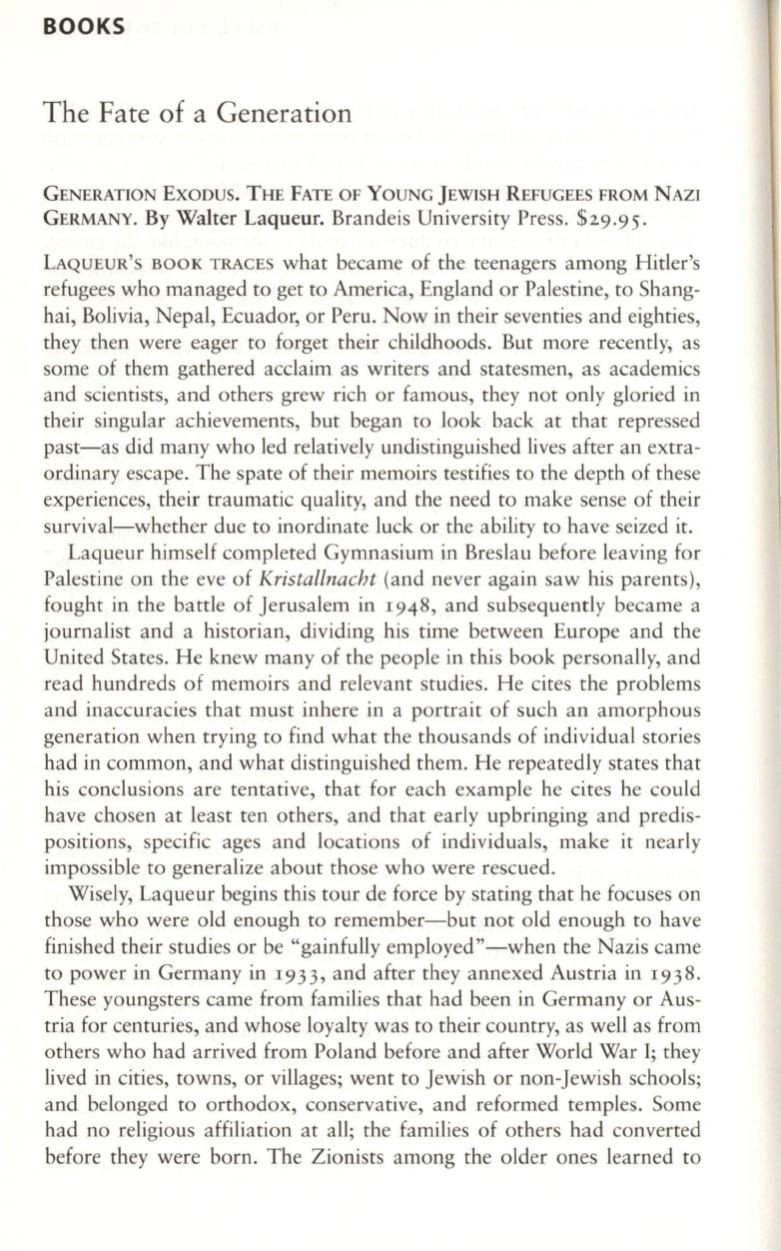
BOOKS
The Fate of a Generation
GENERATION EXODUS.
THE
FATE OF YOUNG JEWlSH REFUGEES FROM NAZI
GERMANY. By Walter Laqueur. Brandeis University Press. $29.95.
LAQUEUR'S BOOK TRACES what became of the teenagers among Hitler's
refugees who managed to get to America, England or Palestine, to Shang–
hai, Bolivia, Nepal, Ecuador, or Peru. Now in their seventies and eighties,
they then were eager to forget their childhoods. But more recently, as
some of them gathered acclaim as writers and statesmen, as academics
and scientists, and others grew rich or famous, they not only gloried in
their singular achievements, but began to look back at that repressed
past-as did many who led relatively undistinguished lives after an extra–
ordinary escape. The spate of their memoirs testifies to the depth of these
experiences, their traumatic quality, and the need to make sense of their
survival-whether due to inordinate luck or the ability to have seized it.
Laqueur himself completed Gymnasium in Breslau before leaving for
Palestine on the eve of
Kristallnacht
(and never again saw his parents),
fought in the battle of Jerusalem in 1948, and subsequently became a
journalist and a historian, dividing his time between Europe and the
United States. He knew many of the people in this book personally, and
read hundreds of memoirs and relevant studies. He cites the problems
and inaccuracies that must inhere in a portrait of such an amorphous
generation when trying to find what the thousands of individual stories
had in common, and what distinguished them. He repeatedly states that
his conclusions are tentative, that for each example he cites he could
have chosen at least ten others, and that early upbringing and predis–
positions, specific ages and locations of individuals, make it nearly
impossible to generalize about those who were rescued.
Wisely, Laqueur begins this tour de force by stating that he focuses on
those who were old enough to remember-but not old enough to have
finished their studies or be "gainfully employed"-when the Nazis came
to power in Germany in 1933, and after they annexed Austria in 1938.
These youngsters came from families that had been in Germany or Aus–
tria for centuries, and whose loyalty was to their country, as well as from
others who had arrived from Poland before and after World War
I;
they
lived in cities, towns, or villages; went to Jewish or non-Jewish schools;
and belonged to orthodox, conservative, and reformed temples. Some
had no religious affiliation at all; the families of others had converted
before they were born. The Zionists among the older ones learned to


